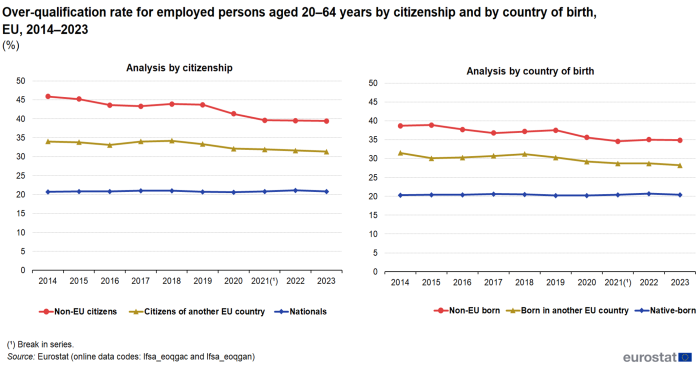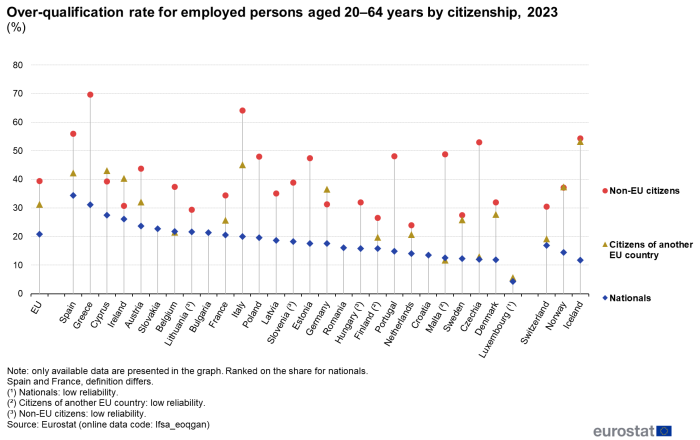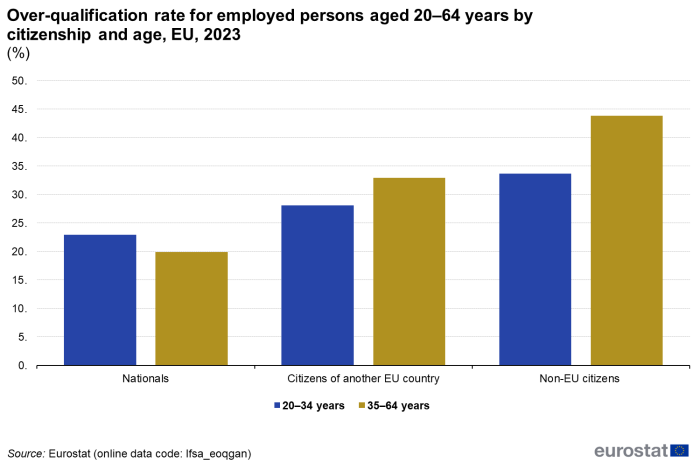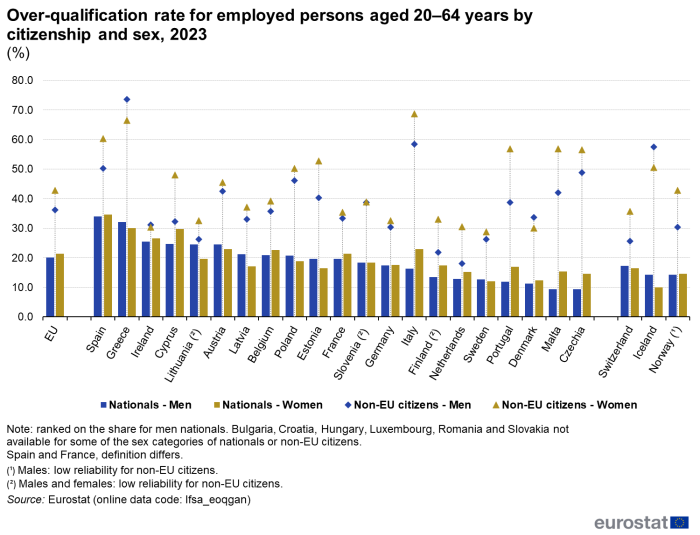Data extracted on 4 July 2024.
Planned article update: 4 August 2025.
Highlights
In 2023, the over-qualification rate was 39.4 % for non-EU citizens and 31.3 % for citizens of other EU countries compared with 20.8 % for nationals.
In 2023, nationals had higher over-qualification rates for younger persons aged 20-34 compared to older persons (35-64). In contrast, for citizens of other EU countries and non-EU citizens, the rate was higher for older persons.
In 2023, over-qualification rates in the EU were higher for women than for men: nationals (21.3 % vs. 20.1 %), citizens of other EU countries (32.9 % vs. 29.7 %), with the biggest gap among non-EU citizens (42.9 % vs. 36.2 %).
Over-qualification rate for persons aged 20–64 years by citizenship, EU, 2014–2023
This article presents European Union (EU) statistics on over-qualified employed persons, providing insights into how foreign citizens compare with nationals in terms of skills and successful participation in the labour market.
The information presented in the article refers to people aged 20–64 years. Over-qualified employed people are persons with a tertiary level of educational attainment (hereafter referred to as tertiary-educated persons) working in low- or medium-skilled occupations. This may also be referred to as a 'vertical' skills mismatch.
This article forms part of the online publication on migrant integration statistics.
Overview of the over-qualification rate
The EU labour force survey (EU-LFS) is the source of data for this article. The main focus of this article is the age group 20–64 years. This age group is of particular interest as it is at the centre of employment analyses in the Action Plan on Integration and Inclusion 2021–2027.
People need skills and qualifications to participate successfully in the labour force. Data on qualifications, measured by the highest level of educational attainment, are an important indicator of the skills offered in the labour market. Higher educational attainment is generally associated with better employment prospects.
This section provides an overview of the over-qualification rate by citizenship and by country of birth. The following two sections present information by citizenship and provide detailed analyses by age and by sex.
Box 1: over-qualification rate
The over-qualification rate is calculated for employed persons with a tertiary level of educational attainment (international standard classification of education (ISCED) levels 5–8). The rate shows the proportion of these people who are employed in a low- or medium-skilled occupation (international standard classification of occupations (ISCO) major groups 4–9). More information on tertiary education and low- or medium-skilled occupation is provided in the Data sources section of this article.

(%)
Source: Eurostat (lfsa_eoqgan) and (lfsa_eoqgac)
Tertiary-educated persons who are foreign-born or foreign citizens have a less favourable employment situation throughout the period from 2014 to 2023 (Figure 1). Compared to native-born individuals or nationals, it is more likely that their formal qualifications are not fully used in the labour market.
The differences between nationals and non-nationals have, however, narrowed: while the rate for nationals remained relatively stable (from 20.7 % in 2014 to 20.8 % in 2023), the rate for non-EU citizens decreased from 45.9 % in 2014 to 39.4 % in 2023. In the same period, the value for citizens of other EU countries also declined, albeit to a lesser extent (from 34.0 % to 31.3 %).
When analysed by country of birth, a broadly similar pattern can be observed, albeit with smaller differences between the three subpopulations. In the below sections, the article focuses on the analysis by citizenship.

(%)
Source: Eurostat (lfsa_eoqgan)
Over-qualification rates varied between EU countries and different groups of citizenship, although with some common features (Figure 2). The lowest over-qualification rates in 2023 were generally observed for nationals of the country they live in while the highest was generally observed for non-EU citizens. Among the EU countries for which complete and reliable data are available, the only exceptions to this were:
- Belgium where citizens of other EU countries had the lowest rate, and
- Cyprus, Germany and Ireland, where citizens of other EU countries had the highest rate.
Among all EU countries with reliable data, the highest over-qualification rates observed in 2023 were in Greece (69.6 %) and Italy (64.1 %), both for non-EU citizens. By contrast, the lowest rate was in Luxembourg for citizens of another EU country (5.6 %).
The countries with the largest gap between nationals and non-EU citizens were Italy and Greece. In Italy, where the difference was greatest, the minimum value observed for nationals was below the EU average (20.0 % vs 20.8 %), while the maximum value observed for non-EU citizens was well above it (64.1 % vs 39.4 %). In Greece, high rates above the EU average were observed for both nationals (31.1 %) and non-EU citizens (69.6 %).
Analysis of the over-qualification rate by age
Figure 3 provides an analysis of the groups of citizenship by age, to compare the over-qualification rates of younger persons aged 20–34 years with those aged 35–64 years.

(%)
Source: Eurostat (lfsa_eoqgan)
In 2023, over-qualification rates in the EU were higher for older persons compared to younger ones among both non-EU citizens and citizens of other EU countries. In contrast, among nationals, younger people had higher over-qualification rates. Nationals had the lowest rates, with 19.9 % for older persons and 22.9 % for younger ones, whereas the highest rates were recorded for non-EU citizens (33.7 % for younger persons and 43.8 % for older ones).
The differences in over-qualification rates among different citizenship groups were greater for older people than for younger people. The gap between nationals and non-EU citizens was 10.8 percentage points (pp) for younger people, whereas this difference widened to 23.9 pp for older people.

(%)
Source: Eurostat (lfsa_eoqgan)
Figure 4 provides an analysis comparing over-qualification rates by age groups between non-EU citizens and nationals, limited to 19 EU countries where data are available. The same comparison is not possible for citizens of other European countries due to limited data availability.
Looking at the data for nationals, it emerges that, in most countries, younger nationals had higher over-qualification rates compared to older nationals. The most significant differences were observed in Greece (38.1 % vs 28.4 %) and Portugal (20.7 % vs 12.4 %). Estonia, Germany, and Spain are exceptions, where older nationals had higher rates than their younger counterparts.
For non-EU citizens, the situation was the opposite in most countries: older persons had higher over-qualification rates compared to younger ones. For countries with reliable data, the most significant differences were observed in France (42.6 % vs 25.0 %) and Italy (68.1 % vs 52.3 %). Cyprus, Czechia, Malta, Portugal and Sweden were exceptions, where the highest rate was observed among younger persons.
For all countries, non-EU citizens aged 20 to 34 had a higher over-qualification rate compared to nationals in the same age group. This difference was, however, limited in France (25.0 % vs 24.9 %) and Ireland (30.1 % vs 30.0 %), while the highest differences were observed in Czechia (56.0 % vs 14.9 %) and Malta (50.5 % vs 14.5 %).
For older persons, non-EU citizens aged 35 to 64 always had a higher over-qualification rate compared to nationals in the same age group. This difference was somehow smaller in Ireland (31.2 % vs 24.6 %) and Lithuania (29.5 % vs 21.4 %), while the highest differences were observed in Italy (68.1 % vs 18.5 %) and Czechia (51.4 % vs 11.0 %).
Analysis of the over-qualification rate by sex
Figures 5 provides an analysis of groups of citizenship by sex, comparing the over-qualification rates of women with those of men.

(%)
Source: Eurostat (lfsa_eoqgan)
In 2023, over-qualification rates in the EU were higher for women than for men among all three population groups. However, the difference among sexes was the smallest for nationals (21.3 % for women and 20.1 % for men), while a more significant difference was observed for both citizens of other EU countries (32.9 % vs 29.7 %) and non-EU citizens (42.9 % vs 36.2 %).
The differences in over-qualification rates among citizenship groups were greater for women than for men. In particular, the gap between nationals and non-EU citizens was 16.1 pp for men, whereas it widens to 21.6 pp for women.

(%)
Source: Eurostat
Source: Eurostat (lfsa_eoqgan)
Figure 6 provides an analysis comparing over-qualification rates by sex between non-EU citizens and nationals, for the 21 EU countries where data are available. The same comparison is not possible for citizens of other European countries due to limited data availability.
In all 21 EU countries, non-EU citizens had higher over-qualification rates compared to nationals, both for men and women. For men, the most significant differences were observed in Italy (58.5 % vs 16.3 %) and Greece (73.6 % vs 32.1 %). For women, the most significant differences were observed in Italy (68.7 % vs 23.0 %) and Czechia (56.6 % vs 14.5 %).
Non-EU citizen women had a higher over-qualification rate compared to non-EU citizen men for almost all presented countries, with Denmark, Greece and Ireland being the exception. The highest differences were observed in Portugal (56.8 % vs 38.8 %) and Cyprus (48.0 % vs 32.2 %).
For nationals, in most countries, women had a higher over-qualification rate compared to men. The largest differences were observed in Italy (23.0% vs. 16.3%) and Malta (15.4 % vs. 9.4 %). Austria, Estonia, Greece, Latvia, Lithuania, Poland, and Sweden were exceptions, with higher rates observed among men.
Source data for graphs
Data sources
The data presented in this article are from the EU labour force survey (EU-LFS), the largest household sample survey in the EU. The survey covers the resident population, defined as all people usually residing in private households. As such, persons living in collective households are excluded from the target population. Usual residence means the place where a person normally spends the daily period of rest, regardless of temporary absences for purposes of recreation, holidays, visits to friends and relatives, business, medical treatment or religious pilgrimage. The data for the EU are aggregated results for the 27 EU countries. For more information on the data sources used, please consult the online publication EU labour force survey.
Due to the sampling nature of the survey, some data have low reliability or are not published due to very low reliability or confidentiality. Data that are of low reliability are duly marked in the footnotes below the figures and tables.
Main concepts
An employed person is someone aged 15–89 years who, during the reference week of the labour force survey, performed work – even if just for one hour a week – for pay, profit or family gain. Also included are people who were not at work but had a job or business from which they were temporarily absent. Employment can be measured in terms of the number of persons or jobs, in full-time equivalents or in hours worked. All the estimates presented in this article use the number of persons.
Educational attainment refers to the highest level of education successfully completed. Educational levels are defined and classified in the international standard classification of education (ISCED). The levels of education used in this article are based on ISCED 2011. A high level of educational attainment refers to ISCED levels 5–8 (tertiary education).
- ISCED level 5: short-cycle tertiary education
- ISCED level 6: bachelor's or equivalent level
- ISCED level 7: master's or equivalent level
- ISCED level 8: doctoral or equivalent level
For the calculation of the tertiary educational attainment share, the numerator refers to persons aged 20–64 years with a tertiary educational attainment (ISCED level 5-8). The denominator is the total population of the same age group, excluding respondents who did not answer the question 'highest level of education or training successfully completed'.
Occupations of employed persons are defined and classified in the international standard classification of occupations (ISCO). The occupations used in this article are based on ISCO-08. At the highest level, ISCO-08 is composed of 10 major groups. Low or medium-skilled occupations include the following major groups.
- Major group 4: clerical support workers
- Major group 5: services and sales workers
- Major group 6: skilled agricultural, forestry and fishery workers
- Major group 7: craft and related trades workers
- Major group 8: plant and machine operators and assemblers
- Major group 9: elementary occupations
As such, the occupations that are not considered to be low or medium-skilled are managers, professionals, technicians and associate professionals, and armed forces occupations.
Country notes
Definition differs for Spain and France. For more information please refer to metadata for LFS main indicators.
Calculation of rates
The rates calculated in this article exclude people classified in the not stated or unknown categories.
Context
Well-functioning labour markets depend largely on matching the skills and qualifications of the labour force to those sought by employers. Although some mismatches are inevitable (especially in rapidly developing sectors of the economy), high and persistent mismatches may be costly for employers, workers and society at large.
Education and skills mismatches are considered especially relevant for vulnerable groups, such as older workers, young people moving from education into work or migrants. One particular issue that impacts on non-EU citizens is (lower) recognition for their professional qualifications: EU citizens may benefit from initiatives such as the recognition of professional qualifications. Easier and more accessible recognition procedures, as well as opportunities for adult migrants to upgrade or equalise their qualifications, including access to lifelong learning, may help enhance the employability of migrants.
In November 2020, an Action Plan on Integration and Inclusion 2021–2027 (COM(2016) 377 final) was adopted with the purpose of fostering social cohesion and building inclusive societies for all. Inclusion for all is about ensuring that EU policies are accessible to and work for everyone, including migrants and EU citizens with a migrant background. This plan includes actions in four sectoral areas (education and training, employment and skills, health, and housing) as well as actions supporting effective integration and inclusion in all sectoral areas at the EU, Member State and regional levels, with a specific attention paid to young people.
More information on the policies and legislation in force in the area of migrant integration can be found here.
Explore further
Other articles
Database
- LFS series - detailed annual survey results (lfsa)
- Population – LFS series (lfsa_pop)
- Employment rates - LFS series (lfsa_emprt)
- Total unemployment - LFS series (lfsa_unemp)
- Employment (mii_emp)
- Unemployment (mii_une)
Thematic section
Publications
Methodology
- LFS series – Detailed annual survey results (ESMS metadata file – lfsa_esms)
- EU labour force survey
